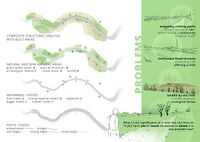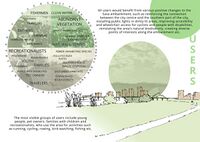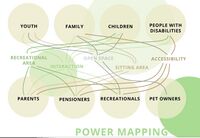LED2LEAP 2021 - Zagreb Team 2
>>>back to working groups overview
For help with editing this Wiki page use this link.
For assignments and key readings use this link.
Landscape Democracy Rationale
Our objective is to identify and respond to clearly visible landscape problems along the Sava river in an inclusive and democratic way. Although reaction is necessary to transform the area into an accessible and sustainable space, it is imperative to make community members main contributors in any landscape project or practice.
Location and Scope
Phase A: Mapping Your Community
Welcome to Your Community and Their Landscape
Due to the big site area, there is a diversity of communities that inhabit the space around The Sava River. They include a lot of contrasting users who vary from low income communities more present in the eastern parts to high income communities more present in the western parts. The most visible users are the ones who use the space for recreation (families, students, youth, elderly people) and sport (sports club members). Some problems include inaccessibility of the river itself (especially for people with physical disabilities), monotony of the area, division of the north and the south part of the city, health issues due to garbage disposal situated very close to the river and overall lack of content which would activate the space around the river thus making it a place of quality leisure time. There is also a question of privatization which leads to transformation of neglected, unused public areas into privately-owned areas which are more profit than community driven. One of the examples is a golf club just south of the river. While the quality of the space is far from low, it's unavailable for the majority of the citizens of Zagreb.
We have singled out few most important challenges which we found as most important:
- no access to the river as well as low access due to pavement (people with disabilities)
- paths on embankments that are not continuous and on few points can be dangerous, not paved and expect drastic change of direction (walking under the bridge which can provide problems to cyclist or parents with children)
- lack of content that invites people to use the area
- biggest problem is ecological - situation of garbage disposal being positioned right next to river, across protected landscape area and orinthological reservoar as well as aquifer area
Groups of Actors and Stakeholders in Your Community
Urban points where communities gather can be divided into two basic groups: anthropogenic and natural points. Anthropogenic being tram turnaround where a lot of different communities gather and natural being parks where communities meet for various kinds of activities. Various and wide range of groups are present due to large area. There are recreational athletes for horse riding, runner or cyclist as well as people just having barbecue and socializing. There are people who respect the space as well and people who don't. That can also be interpreted on how people perceive the space, having people asked, many of them don’t perceive river Sava as something that exists thus having Sava at big risk of being polluted. There is lack of responsibility for space maintenance by the authorities
Relationships Between Your Actors and Groups
There are people who respect the space as well and people who don't. That can also be interpreted on how people perceive the space, having people asked, many of them don’t perceive river Sava as something that exists thus having Sava at big risk of being polluted. There is lack of responsibility for space maintenance by the authorities. The area should be more accessible to the general population. There has to be more consent in the area to attract the population to use it. These zones should be various and should cover all the needs the community has. In planning this zone the community HAS TO BE INVOLVED. They can range from recreational sites, to sitting areas. Conservation of various areas has to be done, and garbage disposal has to be resituated.
Summary of Your Learnings from the Transnational Discussion Panel
- Various scales of international projects
- Different analysis and approaches to areas
- Variety of visual language and visual thinking in presentations
- Informations about the communities inhibiting various areas
Theory Reflection
Exploring given literature has given us insight into how democracy can be integrated into landscape and how interdisciplinary, complex and unique the relationship is. From the first step, site visit, to the last step we had so far, we have learned and cleared our vision about what landscape democracy is, and through given examples and lectures we have defined our vision on the importance of implementing landscape democracy into practise.
- Landscape Convention Contribution to human rights, democracy and sustainable development (Council of Europe, 2018)
Based on the book it is concluded that the relationship between human rights, democracy and sustainable development in connection with landscape depends on multiple factors and is a very unique relationship that applies differently depending on the situation. There have been identified few relevant approaches to how to practice democracy on different levels from which few are: local, national, international level as well as European Union level.
- Editors Shelley Egoz, Karsten Jørgensen, Deni Ruggeri (2018): Defining Landscape Democracy (introductory chapter)
The book questions the very concept of landscape democracy, ie. its meaning and application through a collection of essays and research by professionals from Western and non-Western countries. The main question being tried to answer is “How democratic is the landscape around us and is there a path to spatial justice in it?” The contribution of liberal and neoliber democracy has had impact on contribution, as well as, ripping away from democracy of space e.g. the critique of liberal democracy is that i had introduced the privatization of public space, automatically taking away accessible space he once had and puts it under the administration of private.
- Kühne, Bruns et al: Landscape Culture - Culturing Landscapes
Making its way around a lot of topics, this book goes from How the concepts of landscape is understood, to What it is as component to biodiversity and ecosystems, to historical importance etc. To emphasize this book we have singled out a few quotations that left an impact on us: "Perception is often restricted to the visual landscape. Landscape experience refers to the whole arousal resulting from sensing the landscape.”; "Landscapes are the combined manifestation of the natural and cultural variety in the world in space and time”; “Current landscapes and landscape development, such as sub-urbanized areas, post-montane and post-industrial areas, agro-industrial areas, ‘energy landscapes’, etc. offer little resemblance to images of “traditional cultural landscapes” (Hauser, 2013; Hartz, 2013) “
- Hester, Randolph (2006): Design for Ecological Democracy
The author emphasizes 3 (physical) forms that must be met in the design of a city in order for the design to be in the role of supporting (ecological) democracy. Of which are: enabling form, resilient form and impelling form. enabling form is the element that will encourage the community to get to know each other and empower each other. A simple and banal example given by the author is the bench in front of the post office, which by its positioning becomes a medium for meeting people who are waiting in line or are in / out of the office. Resilient form represents the implementation of ecological knowledge in the design process so that the designed spaces are in accordance with environmental conditions (vegetation, climate, hydrology, closely available construction materials) which would reduce maintenance costs, improve and improve resilience and strengthen the connection with the surrounding landscape. Impelling form is best described in quotation: ”Make a city to touch the people's hearts" - a stimulating, enchanting form brings an element of joy and fulfillment of life in a space. In contrast to impersonal, monotonous blocks, the living space should be such that it awakens in us a sense of belonging and a desire to take care of a part of the health of that space, thus taking care of our own health.
- Council of Europe (2000):The European Landscape Convention
There are few important terms regarding landscape architecture, general and special measures that are singled out in this book. Landscape is an area that man perceives and whose character is the result of the interaction of natural and human factors (perception encompasses all the senses). General measures to be taken by signatories to the Convention: legally recognize the landscape as an essential component of the human environment, establish procedures involving the participation of citizens, local and regional authorities in the process of planning, preserving and managing the landscape Special measures: to raise awareness among civil society, private organizations and public authorities about the importance of the landscape and their roles and the changes they bring to the landscape
References
- Landscape Convention Contribution to human rights, democracy and sustainable development (Council of Europe, 2018)
- Editors Shelley Egoz, Karsten Jørgensen, Deni Ruggeri (2018): Defining Landscape Democracy (introductory chapter)
- Kühne, Bruns et al: Landscape Culture - Culturing Landscapes
- Hester, Randolph (2006): Design for Ecological Democracy
- Council of Europe (2000):The European Landscape Convention
Phase B: Democratic Landscape Analysis and Assessment
Your Name and Partner's Name Correspondence
- ''insert text here''
Your Name and Partner's Name Correspondence
- ''insert text here''
Your Name and Partner's Name Correspondence
- ''insert text here''
Your Name and Partner's Name Correspondence
- ''insert text here''
Your Name and Partner's Name Correspondence
- ''insert text here''
Phase C: Collaborative Visioning and Goal Setting
The Scene in Your Story of Visioning
- insert text here
The Actors in Your Story of Visioning
- insert text here
The Story of Visioning
- insert text here
Reflect on Your Story of Visioning
- insert text here
Phase D: Collaborative Design, Transformation and Planning
Your Prototyping Action
- insert text here
The Evolution of Your Prototyping Action
- insert text here
The Plan Behind Your Prototyping Action
- insert text here
The Realization of Your Prototyping Action
- insert text here
Reflect on Your Prototyping Action
- insert text here
Phase E: Collaborative Evaluation and Future Agendas
Collaborative Evaluation and Landscape Democracy Reflection
- insert text here
The Actors in your Collaborative Evaluation
- insert text here
Reflection on the Online Seminar
- insert text here
Reflection on the Living Lab Process
- insert text here
Your Living Lab Code of Conduct
- insert text here
Process Reflection
- insert text here



















